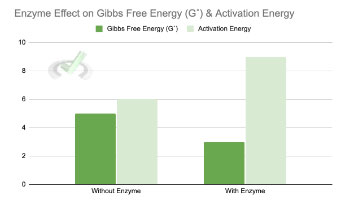I. What is Amino Acid Structure?
Don’t worry, we’re not talking about the Kreb Cycle enzymes just yet! (Although you’ll have a lot of time to do that in your biochem classes, MCAT study prep, & even in med school). However, understanding the basics of enzymes and how they function allow us to build the foundation for understanding how all other enzymes work, from those involved in glycolysis to the pentose phosphate pathway.
Enzyme function covers all aspects including how enzymes catalyze reactions to how they affect the kinetics of various reactions; likewise, enzyme structure covers the basic components of enzymes as well as the function of those components. As you’ll see while we’re covering some of the content information, general chemistry (specifically chemical kinetics) definitely has a significant bridge & overlap, which we’ll also cover later in the article.
Make sure to also look at our other related articles regarding enzymes, proteins, & amino acids! The good thing about studying these MCAT topics is that they all contain a lot of overlap in terms of the content material that you’ll study.
II. Content Review
What’s so special about enzymes? Enzymes are essentially specialized proteins which function to catalyze reactions, a fancy word which just means to speed up the rate of a reaction. The reactions that can be catalyzed are countless: from phosphorylation reactions, oxidation-reduction reactions, etc.
How do enzymes accomplish this?:
They primarily work by reducing the activation energy of the reaction! As shown in the figure below, the line representing the enzyme catalyzed reaction has a much lower activation energy compared to the line without the enzyme present.
Fig. 1A

The structure of the enzyme also goes hand in hand with how they function to reduce the activation energy! There are 2 main sites that are located on enzymes:
Active Site: Site where the substrate binds to the enzyme
Allosteric Site: Site elsewhere on enzymes which can regulate enzyme function via binding to different ligands (comes up a lot when talking about enzyme inhibitors!)
The binding of the substrate to the enzyme’s active site allows results in the substrate reaching its transition state much easier! By doing these, the activation energy is much lower, leading to the reaction proceeding much faster.
Fig. 1B

III. Bridge/Overlap
As stated above, discussions about enzymes have significant overlap with general chemistry, specifically chemical kinetics and thermodynamics.
If there’s anything that you can take away from this article, this is definitely it!: enzymes only affect the KINETICS of a reaction; they have no effect on the THERMODYNAMICS of a reaction.
Kinetics basically refers to how fast a reaction proceeds while thermodynamics refers to equilibrium that is made between the reactants and products, as well as their Gibbs free energy.
The equilibrium established and the GIbbs free energy CAN NOT change, but how fast reactants can achieve equilibrium (i.e. kinetics) CAN be altered via lowering the activation energy .

IV. Wrap Up/Key Terms
Let’s take this time to wrap up & concisely summarize what we covered above in the article!
Enzymes:
Are a specialized class of enzymes that work to catalyze various reactions, which basically means to speed up the rate of the reactions.
=> Accomplished by making it easier for substrates to reach their transition state (TS)
Contains 2 important sites:
Active Site: Site where the substrate binds to the enzyme
Allosteric Site: Sites elsewhere on enzymes which can regulate enzyme function via binding to different ligands
CAN only affect the KINETICS of reactions (i.e. how fast the reaction proceeds); they CANNOT affect the THERMODYNAMICS of reactions (i.e. Gibbs Free Energy, Equilibrium)
V. Practice
Take a look at these practice questions to see and solidify your understanding!
Sample Practice Question 1
Competitive enzyme inhibitors are often called substrate analogues because they mimic the structure of the enzyme’s substrates. As such, which of the following enzyme sites should the competitive inhibitors bind to?
A. Allosteric Site Only
B. Active Site Only
C. Both Allosteric & Active Site
D. Neither Allosteric or Active Site
Ans. B.
Because competitive enzyme inhibitors (substrate analogues) mimic the enzyme’s substrates, they should be competing with them for the enzyme’s active site.
Allosteric sites DO NOT bind to the enzyme;s substrate but can bind to other ligands/molecules in order to regulate the function of the enzyme.
Sample Practice Question 2
Given the following graphs below depicting enzyme effect on activation energy & Gibbs free energy, which of the following correctly depicts how enzymes affect activation energy & Gibbs free energy?
A.

B.

C.

D.

Ans. D.
The most important idea that should be known about enzymes is that they CAN only affect the kinetics (how fast a reaction proceeds) of a reaction; they CANNOT affect the thermodynamics of a reaction (i.e. Gibbs free energy, Equilibrium)
It is only graph D which shows the activation energy of a reaction decreased (kinetics) , while the Gibbs free energy remains the same (thermodynamics). All other graphs show either an increase or decrease in the Gibbs free energy with the enzyme present, which SHOULD NOT happen as thermodynamics are unaffected by enzymes.
VI. Additional Links
Here are some additional links to related articles & additional resources that will hopefully be helpful to you all!
“Enzyme Models & Classification” Study Article: https://docs.google.com/document/d/19M0DOTtCa-MkhItt4utgG-HHr8n1xnxsy_I_p9cWBq8/edit?usp=sharing
“Enzyme Kinetics” Study Article: https://docs.google.com/document/d/1qF0Ltb3YkWSr1x_hzrqu52QnMZt9tU5oYp_djDxg-YY/edit?usp=sharing
“Enzyme Kinetics & Inhibitors” Quicksheets:
TBA



 To help you achieve your goal MCAT score, we take turns hosting these
To help you achieve your goal MCAT score, we take turns hosting these 
























